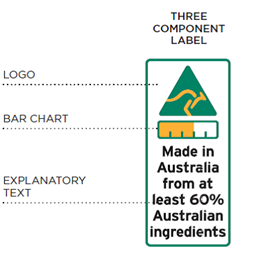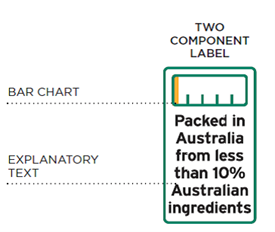
- The kangaroo in the triangle logo shows the product is of Australian origin.
- The bar chart shows the percentage of Australian ingredients in a food
- The explanatory text states whether the food was grown, produced or made in Australia and usually the percentage of Australian ingredients
A single ingredient food can only carry a ‘Grown in Australia’ or ‘Product of Australia’ three component standard mark label if it was grown or produced in Australia. If a food has more than one ingredient it can only carry a ‘Grown in Australia’ or ‘Produced in Australia’ three component standard label if all its ingredients were grown or produced in Australia and all the processing happened in Australia.
Example – Australian pork is cured (using Australian water and an imported brine) and then cooked to make a ham. All of the processing happens in Australia.
The ham cannot carry a ‘Product of Australia’ standard mark because it is not made from exclusively Australian ingredients. The brine is a food additive, not a processing aid. The manufacturer would have to use a ‘Made in Australia’ label.
When a product is made of exclusively Australian ingredients the percentage doesn’t need to be on the label, it is enough to have the bar chart fully shaded.
Example – a butcher sells steaks that are made from Australian cows butchered in Australia.

Food packed in Australia cannot use the three-component standard mark label with the kangaroo logo even if there is some Australian food included. It must use a two-component standard mark label featuring a bar chart and explanatory text in a clearly defined box.

- The bar chart shows the percentage of the Australian ingredients in the food.
- The explanatory text states that the food was packed in Australia and the percentage of Australian ingredients
Deciding the amount of Australian content in a food
If a food is grown, produced or packed in Australia its country of origin labelling must show the percentage of Australian content. This should be shown on the label as the minimum proportion of Australian ingredients.
The percentage on the label must be a whole number no higher than the minimum or average proportion of Australian content in the food. This means all percentages should be rounded down to the nearest whole percentage.
The bar chart is shaded in 10% increments so if a product has 58% Australian content the bar chart would be shaded to 50%.

How to work out the Australian content in a food
To work out the percentage of Australian content in a food, the food is broken down into individual ingredients. You must then work out the weight of each ingredient.
The percentage of Australian content is worked out according to the ingoing weight not the final weight after cooking, curing or processing. For example, the percentage of Australian content in a sausage would be worked out on the raw ingredients not the finished product.
The formula for working out the percentage of Australian content is:
total ingoing weight of ingredients exclusively grown or produced in Australia X 100
total ingoing weight of all ingredients
Sometimes food contains compound ingredients that is ingredients made up of sub-ingredients e.g. pasta in a ready meal is made up of flour, egg and water.
If a compound ingredient contains both Australian and non-Australian sub-ingredients, the ingoing weight of the sub-ingredients must also be broken down to work out the overall percentage of Australian content.
Example – a beef ready meal contains:
- 80g sauce (90% Australian content) = 72g of Australian content
- 60g beef (Australian) = 60g of Australian content
- 60g vegetables (Australian) = 60g of Australian content
- 175g pasta (36% Australian content) = 63g of Australian content
The total ingoing weight of all ingredients is 375g. The ingoing weight of Australian ingredients is 255g.
225 X 100 = 68 %
375
The percentage of Australian ingredients in the beef ready meal is 68%
